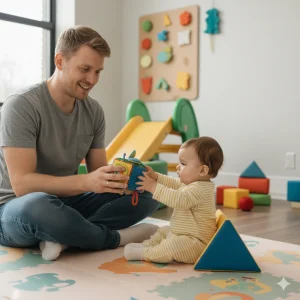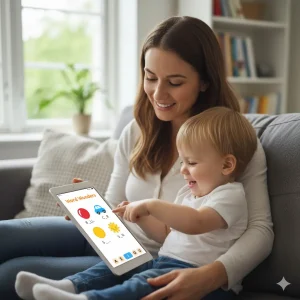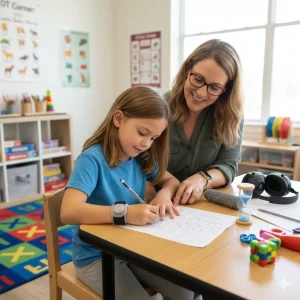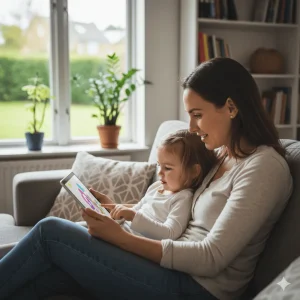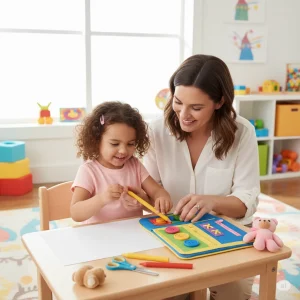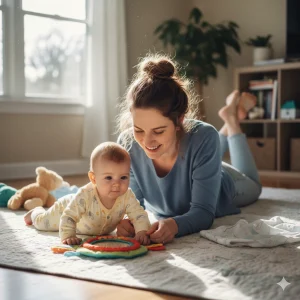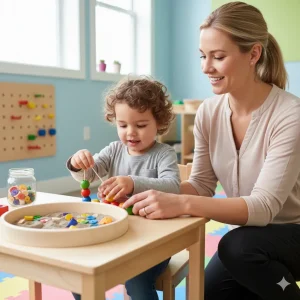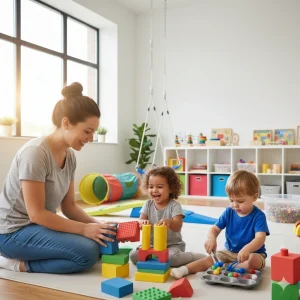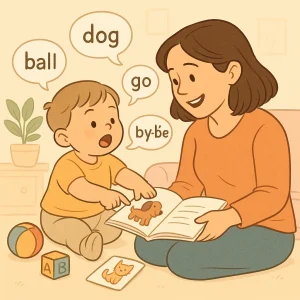Why Your 4-Year-Old Might Be Struggling with Conversation Skills
Last Updated: August 18, 2025
Have you noticed that your 4-year-old struggles with conversation skills—maybe they don’t answer questions, avoid eye contact, or find it hard to keep a back-and-forth exchange going? At this age, most children begin using longer sentences, asking “why” questions, and taking turns in simple conversations. When those milestones don’t show up as expected, it’s natural for parents to worry.
In this guide, we’ll walk through what typical conversation skills in 4-year-olds look like, the red flags for pragmatic language delays, and simple strategies to help your child. You’ll also learn when it may be time to seek support from a speech-language pathologist (SLP). By the end, you’ll know whether your child’s difficulties are just part of normal development—or a sign that extra help could make a big difference.
Free Speech Help for Kids
Concerned about speech delays? Book a free consultation with our expert speech therapist and get guidance tailored to your child’s needs.
What Conversation Skills Should a 4-Year-Old Have?
At age four, children are right in the middle of one of the most exciting stages of language growth. This is when conversation skills in 4-year-olds start to blossom, helping them connect with family, friends, and teachers in more meaningful ways. While every child develops at their own pace, there are some clear speech and language milestones at age 4 that parents can look for.
One of the most important milestones is the ability to take part in back-and-forth conversation. By this age, a child should be able to manage at least 2–3 conversational exchanges. For example, if you ask, “What did you do at preschool today?”, your child might answer, “I painted a picture,” and then respond again when you ask, “What did you paint?”. This natural “serve and return” style of talking shows that your child is learning how to keep conversations going.
Another key skill is answering simple WH-questions like who, what, where, and why. A four-year-old should be able to respond when you ask, “Where is your toy?” or “Why are you laughing?”. This shows that they not only understand questions but can also give meaningful answers that fit the conversation.
Sentence length also grows during this stage. Most four-year-olds begin speaking in sentences of 4–5 words or longer. Instead of saying, “Car go,” your child might say, “The car is going fast.” These longer, more detailed sentences help them explain ideas, share stories, and interact more smoothly with others.
When you combine these skills—taking conversational turns, answering WH-questions, and using longer sentences—you get a picture of how much communication can develop by age four. If your child is showing progress in these areas, it’s a strong sign they are on track with their language milestones.
Signs of Struggles in Conversation Skills
While many children gradually build their language and social abilities, some may show signs that their conversation skills are not developing as expected. If you’ve noticed your 4-year-old not talking in sentences, not answering questions, or struggling to take turns in conversation, these could be red flags worth paying attention to.
One of the most common concerns parents share is a 4-year-old not responding to questions. At this age, children should be able to answer simple “who,” “what,” and “where” questions. If your child often stays silent, gives unrelated answers, or seems to ignore the question, it may point to difficulties with pragmatic language—the social side of communication that helps children know how to use words in everyday interactions.
Another red flag is avoiding eye contact during conversations. While some children are naturally shy, consistent difficulty with making or keeping eye contact can signal challenges in social communication. Eye contact is an important part of learning how to connect with others, and when it’s missing, it often affects how a child’s conversation flows.
You might also notice your child not asking or answering questions on their own. For example, instead of asking, “Can I have some water?”, they may simply point or stay quiet. This can limit how they express needs, share ideas, or connect socially with peers.
Finally, poor turn-taking skills are another sign of struggle. A healthy conversation at age four usually involves some back-and-forth. If your child talks only when prompted, interrupts often, or doesn’t seem to notice when it’s their turn to speak, it may suggest that their conversation skills need extra support.
It’s important to remember that every child develops differently, and occasional difficulties don’t always mean a serious delay. But if these signs are consistent, it’s worth discussing them with a pediatrician or a speech-language pathologist (SLP) to understand whether your child’s challenges are part of typical growth—or a signal that they may benefit from early support.
Why Your 4-Year-Old Might Struggle with Conversation
It can feel worrying when your child doesn’t chat the way you expect. Some parents wonder if their child’s quietness is just shyness or a more serious conversation delay. Understanding the difference—conversation delay vs shyness—is the first step to figuring out what’s really happening. Shy children often can use language but choose not to in certain settings. A child with a true conversation delay, however, may lack the skills to start or continue an exchange, even in comfortable environments like home.
Normal Variations & Shyness
Every child develops at their own pace. Some four-year-olds may be naturally quiet or take longer to “warm up” socially. This doesn’t always mean there’s a problem. Shyness usually shows up in new situations but fades as the child feels safe. The key difference is that shy kids can usually have full conversations once they feel comfortable, while children with delays may continue to struggle no matter the setting.
Hearing or Speech Issues
Sometimes, a child’s language delay vs speech delay is at play. If a child has difficulty hearing clearly—even mild hearing loss from frequent ear infections—they may miss parts of a conversation. This can make answering questions or following along much harder. Similarly, speech sound difficulties (like trouble pronouncing certain words) can limit how much a child participates, simply because talking feels like extra work.
Also read: 9 Effective Exercises to Overcome Speech Delay in Toddlers
Pragmatic Language Disorder
Another possible cause is a pragmatic language disorder, where the challenge isn’t forming words but using them socially. Children may know vocabulary but struggle with skills like taking turns, staying on topic, or reading social cues. For example, they might talk a lot about their favorite toy but not notice when the listener tries to change the subject. These children need guidance in learning the “rules” of conversation.
Autism or Social Communication Disorder
Parents often ask, “Is lack of conversation a sign of autism in 4-year-olds?” In some cases, yes. Children with autism spectrum disorder (ASD) or social communication disorder may show limited back-and-forth exchanges, avoid eye contact, or have difficulty with pragmatic language. It’s important to note that not every child with a delay has autism—but if conversation struggles are combined with other signs like repetitive behaviors or limited play skills, an evaluation is recommended.
at home. With a few playful strategies, your 4-year-old can gain confidence in talking, listening, and taking turns. Everyday routines—like mealtimes, storytime, or even car rides—can become powerful moments for building communication.
Model Turn-Taking and Topic Maintenance
Children learn best by watching and practicing. Show your child how conversations work by modeling turn-taking. For example, during dinner you might say, “I’ll ask you a question, then it’s your turn to ask me one.” Encourage them to stick with a topic for at least two or three exchanges before moving on. This helps teach the idea of topic maintenance, which is an important social skill at age four.
Try Conversation Activities for 4-Year-Olds at Home
Simple, playful activities can spark great conversations. Try asking your child open-ended questions like, “What was your favorite part of today?” or “If you could be an animal, which one would you be?” These kinds of prompts encourage them to answer in more than one or two words, helping them stretch their language skills naturally.
Play Games to Improve Conversation Skills
Children love games—and games are one of the easiest ways to practice talking. Classic preschool games like Simon Says or I Spy are excellent for practicing listening and responding. You can also create your own games to improve conversation skills for preschoolers, like a “Question Ball.” Toss a soft ball back and forth, and whoever catches it has to answer or ask a question. This makes turn-taking fun and interactive.
Use Conversation Starters and Role-Play
Sometimes children need a little extra support to get conversations flowing. Keep a list of conversation starters for 4-year-olds handy, such as “Tell me about your favorite toy” or “What would you do if it rained candy?”. Role-playing activities—like pretending to be a shopkeeper and a customer—also give children safe, playful ways to practice real-life conversation.
Visual Supports Can Help
For children who need more guidance, visual supports like picture cards or social stories can be very effective. Showing a picture of a playground and asking, “What do you see here? What would you do first?” gives your child a clear context to start talking. Visual prompts reduce the pressure and help spark natural conversation.
When to See a Speech Therapist
Sometimes, no matter how much practice you give at home, your child may continue to struggle with conversation. This is when parents begin to wonder, “How do I know when to see a speech therapist for my 4-year-old?” The answer lies in both persistence and impact—if delays don’t improve over time, or if they affect daily life, it’s worth seeking professional support.
A speech-language pathologist (SLP) is the specialist trained to assess and treat children with communication challenges. An SLP will look beyond just vocabulary and pronunciation. They also evaluate pragmatic language skills—the social use of language, such as turn-taking, staying on topic, or asking and answering questions. If your child avoids eye contact, doesn’t respond to questions, or rarely engages in back-and-forth conversation, these are strong signals that a professional evaluation could help.
For many children, speech therapy for pragmatic language is a game-changer. Therapy sessions focus on teaching children how to use words in real-life situations: greeting others, starting and ending conversations, or understanding social cues. An SLP might use role-play, games, or visual supports to build these skills in a way that feels natural and fun.
If your child is in preschool or kindergarten, the SLP may also recommend setting IEP (Individualized Education Program) goals for pragmatic language. These goals outline specific communication skills your child will work on at school, ensuring that teachers, therapists, and parents are all supporting growth consistently.
The most important thing to remember is that early intervention makes a big difference. If you notice persistent delays, don’t wait—getting help sooner allows your child to build the foundation for stronger social and academic success.
Conclusion
Every child grows at their own pace, and some 4-year-olds may take longer to start conversations. A little shyness or short answers are normal, but ongoing struggles with eye contact, not answering questions, or poor back-and-forth conversation can be red flags in 4-year-old conversation skills. The good news is that help is available. A speech-language pathologist (SLP) can assess your child and guide you with speech therapy for pragmatic language. Early support builds confidence, improves social skills, and makes talking fun again. Don’t wait—simple steps today can create big progress tomorrow.
Frequently Asked Questions:
1. What conversation skills should a 4-year-old have?
By age four, most children can use sentences of about 4–5 words, answer simple WH-questions like “what” or “where,” and join in short conversations. A typical 4-year-old should be able to have at least 2–3 back-and-forth exchanges. For example, if you ask, “What did you eat for lunch?”, your child might say, “I had rice,” and then add more when you ask a follow-up question. These skills show that your child’s conversation skills in 4-year-olds are developing as expected.
2. Why is my 4-year-old not talking in sentences?
It’s normal for some children to talk later than others, but by age four, most kids are able to use full sentences. If your 4-year-old is not talking in sentences yet, it may be due to a language delay, hearing problems, or difficulties with speech sounds. If you notice your child only uses single words or very short phrases, it’s a good idea to speak with a speech-language pathologist (SLP) for guidance.
3. Is it normal for a 4-year-old not to answer questions?
Sometimes children get shy, distracted, or tired and may not answer right away—that can be normal. But if your 4-year-old is not responding to questions most of the time, it may be a sign of a pragmatic language delay. At this age, children should be able to answer simple questions like, “Where is your toy?” or “What is that?”. Consistent difficulty with answering can signal that your child may need extra support.
4. How do I know if my 4-year-old has a conversation delay vs shyness?
Many parents wonder about conversation delay vs shyness. A shy child might stay quiet in new situations but usually talks more when they feel safe at home. A child with a conversation delay struggles everywhere—even with family. If your 4-year-old rarely joins conversations, avoids answering questions, or doesn’t try to start talking at home or school, it’s more likely a delay than shyness.
5. Is lack of conversation a sign of autism in 4-year-olds?
Not always, but sometimes. Parents often ask, “Is lack of conversation a sign of autism in 4-year-olds?”. Limited eye contact, little or no back-and-forth conversation, not asking questions, or repeating words without real dialogue can be signs of autism. However, not every child with a speech delay has autism. If your child’s struggles with talking also come with repetitive behaviors or limited play skills, it’s important to seek an evaluation.
6. How can I improve conversation skills in my child at home?
You can improve conversation skills in a child by practicing every day in simple ways. Use open-ended questions like, “What did you like best about today?” Encourage turn-taking by modeling how to wait for each other to talk. Read books together and ask your child to describe pictures or predict what happens next. Everyday moments—mealtime, car rides, or play—are perfect times to help your child talk more.
7. What games help 4-year-olds build conversation skills?
There are many fun games to improve conversation skills for preschoolers. Classic games like Simon Says and I Spy encourage listening and responding. Try a “Question Ball”—toss a ball back and forth, and whoever catches it must answer a question like, “What’s your favorite color?” or ask a new one. Role-play games (shopkeeper, doctor, teacher) also help children practice real-life conversations in a playful way.
8. When should I see a speech therapist for my 4-year-old?
Parents often wonder when to see a speech therapist for a 4-year-old. If your child rarely talks in sentences, doesn’t answer simple questions, avoids eye contact, or struggles with back-and-forth conversation for several months, it’s time to seek help. A speech-language pathologist (SLP) can check if the challenges are part of normal growth or a real delay that needs therapy.
9. What is speech therapy for pragmatic language?
Speech therapy for pragmatic language focuses on the social use of words. It’s not only about saying words clearly—it’s about knowing how to use them in daily life. Children in therapy practice skills like taking turns in a conversation, asking and answering questions, staying on topic, and understanding body language. Speech therapists often use games, stories, and role-play so children learn while having fun.
10. Can early speech therapy help my 4-year-old catch up?
Yes, early therapy can make a big difference. If a child has pragmatic language delays or struggles with conversation, starting therapy early helps them catch up faster. An SLP can create fun activities that fit your child’s needs and may even suggest IEP goals for pragmatic language at school. Early support not only improves talking but also builds confidence, helps friendships, and supports success in learning.
About the Author:
Shravanaveena Gajula
M.Sc ., Speech and Language Pathology (5+ years of experience)
Shravanaveena Gajula is a dedicated Audiologist and Speech-Language Pathologist with a BASLP and an M.Sc in Speech and Language Pathology. With experience spanning multiple settings, including Wellness Hub and Ashray Akruti, Veena specializes in a wide range of disorders from developmental issues in children to speech and language assessments in adults. Her expertise includes parent counseling, managing speech sound and fluency disorders, and creating individualized therapy programs. Veena is also PROMPT certified and an author of several insightful blogs on speech and language pathology, aiming to educate and assist caregivers in supporting their loved ones.
Book your Free Consultation Today
Parent/Caregiver Info:
Client’s Details:
* Error Message
